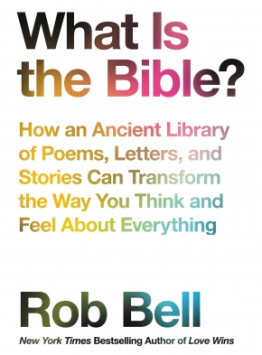Bell, R. (2017). What is the Bible? How an ancient library of poems, letters, and stories can transform the way you think and feel about everything. New York: HarperCollins.
POINT: The Bible is a collection of documents written by many different authors in different places and times that express humanity’s evolving consciousness about the divine.
 Rob Bell’s goal in answering the question “What is the Bible?” is to help people “read the Bible in a better way” (23) so they can discover the radically progressive and optimistic message that it communicates.
Rob Bell’s goal in answering the question “What is the Bible?” is to help people “read the Bible in a better way” (23) so they can discover the radically progressive and optimistic message that it communicates.
The argument of the book is developed in four main parts, each of which consists of many short chapters. In Part 1: There’s Something More Going On Here, the author demonstrates with numerous examples from Scripture how knowledge of cultural and historical backgrounds, attention to the structure of the books and passages, study of key words, etc. can expose meanings in the texts that are not obvious on the surface.
In Part 2: The Nature of That Something, Bell attempts to illustrate with many different biblical narratives what he believes constitutes the “something more” that is going on. Essentially that submerged theme has to do with revolutionary ways of thinking—subversive ideas, stunning plot twists, scrambled categories. Perceptions of God are upended (God is gracious and relatable rather than demanding and vengeful), and “outsiders” (Ninevites, Sidonians, Samaritans) are described as more responsive to God than “insiders” (Israelites/Jews). Such dramatic new insights Bell describes variously as “growth and maturing and expanding perspectives” (117); “radically new ideas about freedom, equality, justice, compassion, and love” (123); and “change and expanding consciousness” (165).
These stories insist in a thousand different ways that we don’t have to settle, that tomorrow doesn’t have to be a repeat of today, that we don’t have to be enslaved to fear or despair—that we can change, move, heal, and we can leave behind whatever needs to be left behind so that we can step into a better future. (181)
Significantly, all of this upheaval in understanding about God and God’s ways in the world occurs at the human level as people observe, ponder, discuss, and figure things out.
Part 3 discusses Where That Something Takes Us, and offers several examples of how to read the Bible in light of the claim that the Bible is a record of evolving human consciousness.
Finally, in Part 4: The Questions That Always Come Up, Bell clarifies his position on numerous Christian doctrines including his beliefs about the Bible. A few highlights:
- Jesus did not “have to” die to appease God; he was betrayed and killed by people.
- The Bible is the “word of God” but so are many other writings.
- The Bible is “authoritative” to the extent that we give it authority.
- “Inerrancy” is not an appropriate category to describe records of personal experiences.
- The Bible is “inspired” in the sense that it helps us to live better lives.
To reiterate: “The Bible is a library of books reflecting how human beings have understood the divine” (295). Therefore the best question to ask about a biblical text, then, is “Why did people find this important to write down?” (289) and the worst question to ask is “Why did God…?” (293)—because God didn’t, people did.
READER’S TURN: How would you answer the question “What is the Bible?”
Read Critique: What Is The Bible? for my analysis of this book.